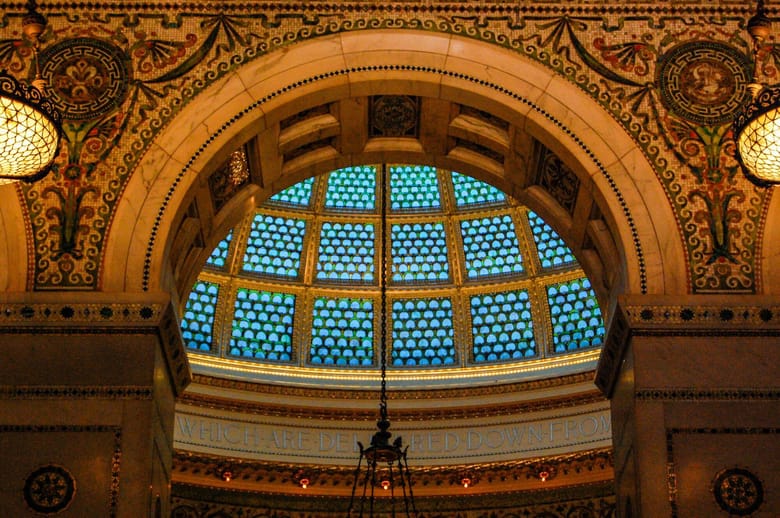Chicago Cultural Center
Who would expect a massive Beaux Arts block in the heart of the city to be a hub of contemporary arts and culture?
Photo by Eric Allix Rogers
Photo by Eric Allix Rogers
Chicago Cultural Center, Photo courtesy of Jen Aguilar
Chicago Cultural Center, Photo courtesy of Raina Regan
The Chicago Cultural Center’s heavy walls have hosted a dynamic series of events and exhibitions over the years, including the inaugural Chicago Architecture Biennial. The building that became the nation’s first free, city-operated cultural center started out as something quite different.
THE CITY’S FIRST PUBLIC LIBRARY
Chicago had no public library until a group of English donors, mistakenly believing that they were replacing books that had burned in the Great Fire of 1871, furnished 8,000 titles to the rebuilding city. The books were housed in an empty iron water tank in 1872, then moved around the Loop until their first permanent home was completed in 1897.
THE PEOPLE’S PALACE
Boston architects Shepley, Rutan & Coolidge had designed the Art Institute for the 1893 World’s Columbian Exposition in the classical style Daniel Burnham set for the fair. Their plans for the city’s first public library followed suit on an even grander scale—to the tune of $2 million. They designed an interior as lavish as the limestone exterior was restrained. Sumptuous marbles and vast, vivid mosaics marked the building’s grand spaces, some inspired by Venetian landmarks.
Today, the Cultural Center’s surmounting glories are a pair of remarkable stained-glass domes. Grand Army of the Republic Hall features an intricate Renaissance pattern, though the glass is dark with age. Preston Bradley Hall’s enormous Tiffany dome—the world’s largest—shines with newly-restored opalescent color.
By the mid-1960s, the building, like many structures of its age, seemed obsolete. Demolition was a real possibility—although a dogged group of historic preservationists, most notably Charles Staples and the organization that eventually became Landmarks Illinois, advocated tirelessly for its preservation.
When a committee was appointed to determine the future of the building in 1972, Eleanor “Sis” Daley, the reticent wife of Mayor Richard J. Daley, spoke up on its behalf, saying “I am for restoring and keeping all the beautiful buildings.” Her one-sentence pronouncement is perhaps given too much credit for saving the building, but it made clear that preservation advocates had found their mark. A sensitive renovation added exhibition spaces while allowing the building to continue to serve its original purpose for another decade.
Finally, after the dedication of the new Harold Washington Library in 1991, Lois Weisberg, Mayor Richard M. Daley’s first Commissioner of Cultural Affairs, completed the building’s transformation into the Chicago Cultural Center. The space is now dedicated to making the arts a free and central part of Chicagoans’ everyday lives.
Did you know?
The building's Tiffany dome measures 38 feet in diameter and contains 30,000 pieces of glass! It was restored in 2008.
Did you know?
Although they’re the same height overall, the north and south wings of the building have four and five floors, respectively, a vestige of the different purposes for which the wings were originally constructed.
Did you know?
The building’s masonry outer walls are three feet thick.

















